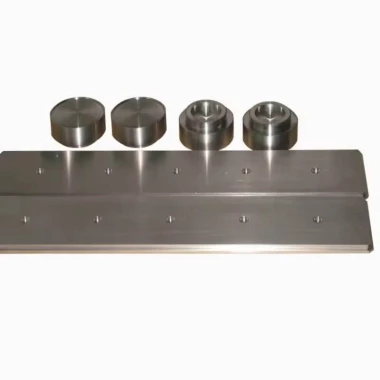The application of molybdenum sputtering targets is mainly concentrated in flat-panel displays, thin-film solar cell electrodes and wiring materials, and semiconductor barrier materials. These materials are based on molybdenum with high melting point, high conductivity, and low specific impedance, and have good Corrosion resistance and environmental performance.
Molybdenum Sputtering Target details
The molybdenum planar target is processed from our company's high-quality plates. It has the characteristics of high density, no internal cracks and blisters, bright surface, uniform color and accurate size.
Small molybdenum spinning targets are processed from high-quality rods and have the characteristics of accurate dimensions, smooth surface, and high purity.
Regular size molybdenum rotating targets are produced using the hot isostatic pressing process and feature high density (density up to 10.15 g/cm3), fine grains, and good molding.
Conventional density: 10g/cm³~10.15 g/cm³;
Special process density: greater than 10.15g/cm³.
The requirements for sputtering targets are higher than those in the traditional material industry. General requirements include: size, flatness, purity, impurity content, density, N/O/C/S, grain size and defect control; higher requirements or special requirements Including: surface roughness, resistance value, grain size uniformity, composition and structure uniformity, foreign matter (oxide) content and size, magnetic permeability, ultra-high density and ultra-fine grains, etc. Magnetron sputtering coating is a new type of physical vapor coating method. It uses an electron gun system to emit and focus electrons on the material to be plated, so that the sputtered atoms follow the momentum conversion principle and fly away from the material with higher kinetic energy. Deposit a film onto a substrate. This plated material is called a sputtering target. Sputtering target materials include metals, alloys, ceramic compounds, etc.
Magnetron sputtering coating is a new type of physical vapor coating method. Compared with evaporation coating method, it has obvious advantages in many aspects. As a relatively mature technology that has been developed, magnetron sputtering has been applied in many fields.
Sputtering technology, sputtering is one of the main technologies for preparing thin film materials. It uses ions generated by an ion source to accelerate and gather in a vacuum to form a high-speed ion beam that bombards the solid surface. The ions and atoms on the solid surface are generated. Kinetic energy exchange causes the atoms on the solid surface to leave the solid and deposit on the substrate surface. The bombarded solid is the raw material for preparing thin films deposited by sputtering, which is called a sputtering target. Various types of sputtered thin film materials have been widely used in semiconductor integrated circuits, solar photovoltaics, recording media, flat displays, and workpiece surface coatings.
Sputtering targets are mainly used in the electronics and information industries, such as integrated circuits, information storage, liquid crystal displays, laser memories, electronic control devices, etc.; they can also be used in the field of glass coating; they can also be used in wear-resistant materials, high-temperature corrosion resistance , decorative supplies and other industries.
Molybdenum targets are widely used in many fields. The following are some common uses of molybdenum targets:
1. Thin film deposition: Molybdenum targets can be used to prepare molybdenum thin films using physical vapor deposition (PVD) or magnetron sputtering. These films usually have excellent conductive properties, high melting points and corrosion resistance, and are therefore often used to prepare conductive layers, barrier layers, metal connecting lines and other applications. Molybdenum thin films are a common material in areas such as integrated circuit manufacturing and thin-film solar cells.
2. Vacuum equipment and thermal barrier coating: Due to molybdenum’s high melting point, low evaporation rate and good thermal stability, molybdenum targets can be used to prepare components in vacuum equipment, such as tungsten-molybdenum alloy valves, tungsten-molybdenum heaters, etc.
In addition, molybdenum can also be used to prepare thermal barrier coatings in high-temperature applications to improve the heat resistance of materials and protect base materials.
3. Optical coating: Molybdenum targets are also used in the optical field. By depositing thin films of molybdenum, coatings with specific optical properties can be produced, such as mirrors, filters and transmission films. Molybdenum films have good reflective properties in the infrared spectral range and are therefore commonly used in infrared optics and laser systems.
4. Electronic devices: Molybdenum targets also have important applications in the manufacturing of electronic devices. For example, in display technology, molybdenum films can be used as backsheets for displays with good electrical conductivity and thermal stability.
In addition, molybdenum is also used as a contact, electrode and wire material in electronic devices.
5. Materials research and laboratory applications: Molybdenum targets are also widely used in scientific research and laboratory applications. It can be used as a target material to study film growth, surface modification and material properties.
In addition, molybdenum targets can also be used for electron microscope (SEM) sample preparation, X-ray fluorescence spectrometer (XRF) standards and other applications
The properties of molybdenum sputtering targets are the same as (pure molybdenum or molybdenum alloys). Molybdenum is a metallic element primarily used in steel. Most of it is directly used in steelmaking or cast iron. Small amounts of molybdenum are smelted into ferromolybdenum or molybdenum foil, which is then used to make steel. It can improve the strength, hardness, weldability and toughness of the alloy, as well as high temperature resistance and corrosion resistance.











